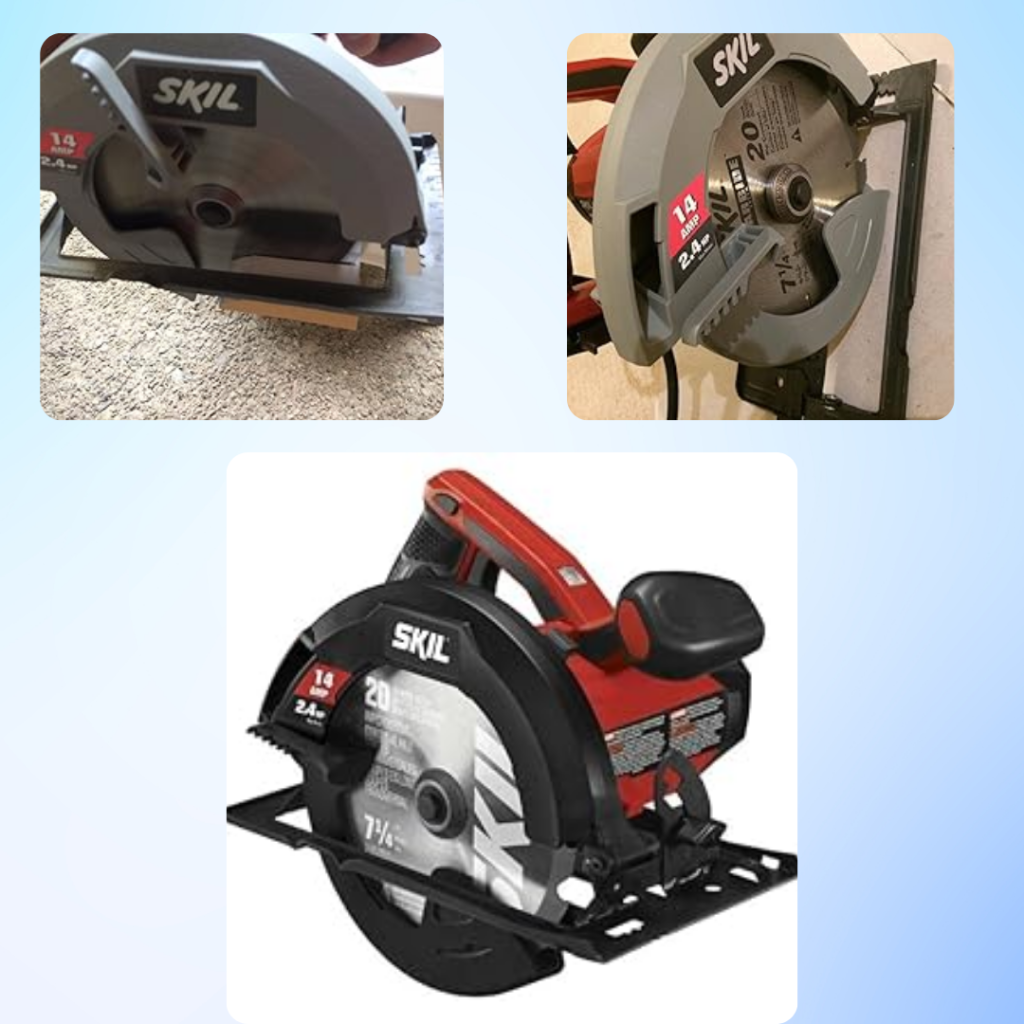Ever asked, How many amps does a circular saw use? If you’ve done a DIY project, you know power makes a big difference. I learned this when my saw slowed down on thick wood. It was frustrating! In this guide, I’ll explain circular saw amps in simple terms and whether more amps are better for power tools. Let’s find the right saw for you!
Understanding Amps in a Circular Saw
What Are Amps and Why Do They Matter?
Amps (A) show how much power a saw uses. More amps mean more strength. A weak saw can slow down or overheat, making cuts harder. If your saw struggles, it might not have enough power.
How Amps Affect Performance and Durability
Higher amps help a saw cut faster and easier. A low-amp saw works for small tasks but may jam on thick wood. Think of it like a bike—more gears make pedaling smoother. But high-amp saws can get hot, so cooling helps them last. How Many Amps Does A Circular Saw Use.
My Experience: Choosing the Right Amps for the Job
I once used a weak saw on thick wood. It worked at first, then slowed down. My cuts got rough. Switching to a 15A saw was a game-changer. It cut fast and smooth, with no effort. For big projects, a stronger saw is worth it.

How Many Amps Does a Circular Saw Use?
Standard Amp Ratings for Circular Saws
Circular saws usually have 10A, 12A, or 15A motors. A 10A saw works for light tasks. A 15A saw cuts thick wood fast. If you need smooth, quick cuts, go for more amps. How Many Amps Does A Circular Saw Use.
Corded vs. Cordless: Power Differences
Corded saws use 120V power. A 15A corded saw pulls about 1800W. Cordless saws run on batteries, usually 20V or more. They work well but may not match the power of corded ones. Need endless power? Pick corded. Want to move around? Go cordless.
Does More Amps Mean Better Cuts?
Higher amps mean more power, but they also use more energy. A 15A saw handles tough cuts with ease, but for small DIY jobs, a 12A saw works fine. Pick the right power for your project.
Related Power Considerations: How Many Watts Does a Circular Saw Use?
Understanding Amps, Volts, and Watts
Through his demonstration, Watts calculates the power consumption capability of a saw. Finding the wattage strength requires multiplying volts by amps through this basic mathematical equation. The power supply for corded saws rests at 120V, but cordless saws run on 18V or 20V battery units.
Wattage Examples for Different Saws
A 15A saw at 120V uses 1800W (15 × 120). A 15A saw at 120V uses 1800W (15 120), while a 10A saw uses 1200W. More watts mean more power, but they also use more energy. Battery-powered saws have lower wattage but still do the job with efficient motors. How Many Amps Does A Circular Saw Use.
Power Sources: Can Your Outlet Handle It?
All home outlets deliver either 15A or 20A at 120V, which provides sufficient power for circular saw operations. You need to check that your generator provides sufficient wattage for your tool. A generator equipped with 2000W capacity will operate a 15A saw, but weaker generators may not succeed. A proper power connection needs to match the requirements of your saw.

Typical Circular Saw Blade Size and Its Impact on Power Use
Did you know your circular saw blade size affects power use? I learned this the hard way. I swapped my 7 ¼-inch blade for a bigger one, thinking it would cut better. Instead, my saw struggled. That’s when I realized blade size matters. How Many Amps Does A Circular Saw Use.
Common Blade Sizes and Power Use
Circular saw blades come in different sizes. Here are the most common:
- 5 ½-inch – Best for small, cordless saws. Uses less power. Great for light cuts.
- 7 ¼-inch – The standard size. Works for most DIY and pro jobs. Good balance of power and speed.
- 10-inch or larger – Found on heavy-duty saws. Needs more power and torque.
The bigger the blade, the harder the motor works. A larger blade needs more power to keep spinning fast. That’s why a 15A saw handles big blades better than a 10A saw.
How Blade Size Affects Efficiency
Think of it like riding a bike. A small bike is easy to pedal. A big, heavy bike takes more effort. A bigger blade puts more strain on the motor, using more power to stay fast.
Here’s what happens:
- A smaller blade runs smoothly and saves power.
- A bigger blade makes the motor work harder. It can overheat if the saw isn’t strong enough.
I learned this when I tried cutting thick wood with a weak saw. The blade slowed down. The motor got hot. When I switched to a stronger saw, cutting was easy. No slowdowns. No burnouts.
Picking the Right Blade
If you’re cutting thin wood or 2x4s, a 5 ½” or 7 ¼” blade works fine. If you need to cut thick lumber, go for a bigger blade and a 15A saw. How Many Amps Does A Circular Saw Use.
Types of Circular Saws and Their Amp Ratings
The system performs all circular saw procedures through its functional guidelines. All circular saw models incorporate their fundamental components into distinct units among their construction components. Higher-grade circular saw selection enables operators to finish tasks more quickly with limited complexity.
Sidewinder Circular Saws: Light and Quick
Sidewinders represent the most frequently used saws in the market. The motor of this tool is located on the side, providing operators, operators with ease of movement and lightness.
- Amps: 10A to 15A
- Best for: DIY projects, framing, and general use
- Why choose it? It’s affordable, simple to use, and cuts fast.
I used a 15A sidewinder to build a shelf. It sliced through wood smoothly. This is a great pick if you need a powerful yet light saw. How Many Amps Does A Circular Saw Use.
Worm Drive Circular Saws: Strong and Steady
Worm drive saws’ power output and cutting capacity perform better than other types. Strength increases when the motor operates parallel to the blade at the cost of weight.
- Amps: 13A to 15A
- Best for: Deep cuts, tough wood, and big jobs
- Why choose it? It’s powerful, long-lasting, and great for pros.
My friend swears by his worm drive saw. He says you won’t want another kind once you get used to it.
Cordless Circular Saws: Move and Cut Anywhere
Cordless saws run on batteries, so they don’t need a cord.
- The measurement unit for power devices is volts instead of amps, and their output ranges from 18V to 60V.
- The tool works best in situations involving brief tasks, outdoor conditions, and locations with no electrical outlets.
- Why choose it? The unit offers portability with its lightweight design and high convenience.
Once, I had to cut plywood in my backyard. My 20V cordless saw saved me from dragging out an extension cord. It wasn’t as strong as a 15A corded saw, but it did the job.
Which Saw Should You Choose?
- Need speed and easy use? Get a sidewinder.
- Want more power for thick wood? Choose a worm drive.
- Like freedom to move around? A cordless saw is perfect.
Are More Amps Better for Power Tools?
Ever wondered, “Do I need more amps in my circular saw?” More power sounds great, but is it always the best choice? Let’s find out.
Do More Amps Mean a Better Saw?
Pros:
- Stronger cuts – A 15A saw slices through thick wood without slowing down.
- Handles tough materials – It cuts hardwood, plywood, and thick lumber with ease.
- Lasts longer – The motor doesn’t strain as much, so it stays in good shape.
Cons:
- Heavier – More amps add weight, making the saw harder to handle.
- More costly – A high-amp saw costs more than a lower-amp one.
- Needs more power – It uses more electricity, so check your power source.
How Many Amps Do You Need?
- For DIYers – Cutting 2x4s or plywood? A 10A or 12A saw does the job.
- For frequent users – If you build decks or furniture, a 15A saw works better.
- For pros – If you cut all day, a high-amp saw makes things easier.
My Experience: Why I Switched to a 15A Saw
I started with a 10A saw. It worked fine—until I tried cutting thick wood. The saw slowed down, struggled, and even smoked.
Then, I got a 15A saw. Wow! The blade glided through the wood without effort. No slowdowns, no rough cuts—just smooth, easy work. If you cut often, the extra power is worth it.
FAQs: Circular Saw Amps & Power
What’s the best amp rating for a DIYer’s circular saw?
The cutting process of 2x4s or plywood requires only a 10A or 12A saw. I began my DIY project with the 10A saw for basic use, but it worked nicely for my smaller projects. The saw’s power improved substantially after I used the 15A model for tough pieces of wood.
Can I run a circular saw on a generator?
A 15A saw at 120V uses 1800W. If your generator can’t provide enough power, the saw won’t run. I tried using a 2000W generatorcan’ta 15A saw, and it worked fine. I used a smaller generator, but it couldn’t handle the load. Make sure your generator has enough wattage before you can run.
Do higher-amp saws last longer?
A 15A saw can last longer because it’s not pushed as hard. But if you overuse it or don’t let it cool down, it can still break down. After a few months, I once had a cheap 15A saw, but my well-made 12A saw lasted for years. Make sure to choose a good brand and give your saw breaks.
Is amperage the only thing to think about when buying a circular saw?
I used to think higher amps meant a better saw, but that’s not always true. A well-built 12A saw might work better than a cheap 15that. Consider these factors, too:
- The recommended blade size for average jobs measures 7 ¼ inch.
- Motor type makes a difference between light Sidewinders and stronger worm drives.
- Corded saws offer more power, although portable saws run on cordless power.
Conclusion
So, how many amps does a circular saw use? It depends! Now you know why it matters. More amps mean more power, but that’s not the whole story. Blade size, motor type, and corded vs. cordless also make a big difference.
For small DIY projects, a 10A or 12A saw works great. For big jobs, a 15A saw cuts faster and smoother. I learned this when my weak saw struggled with thick wood. Upgrading made cutting easy!
What’s your experience? Have you used a saw that wasn’t strong enough? Or found one that worked like a dream? Share in the comments! Let’s find the best saw together.

Hi, I’m Tom Scalisi, and welcome to The Saw Blog! I started this blog to share my hands-on experience and insights about woodworking tools—especially saws and saw blades. Over the years, I’ve had the chance to work with a wide range of tools, and I’m here to help both professionals and hobbyists make informed decisions when it comes to selecting and using their equipment. Whether you’re looking for in-depth reviews, tips, or just advice on how to get the best performance out of your tools, you’ll find it here. I’m excited to be part of your woodworking journey!
